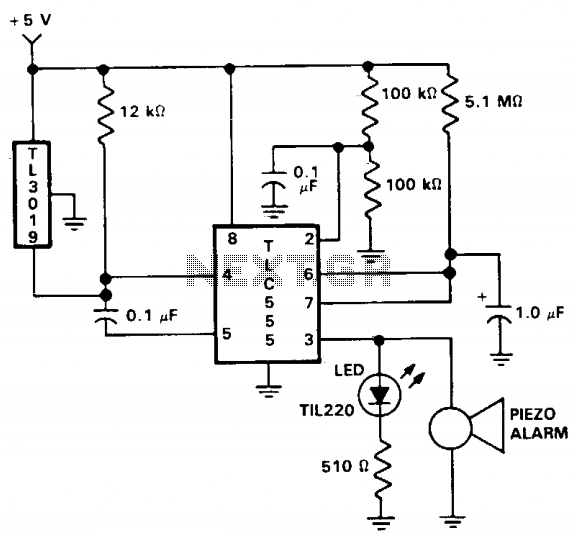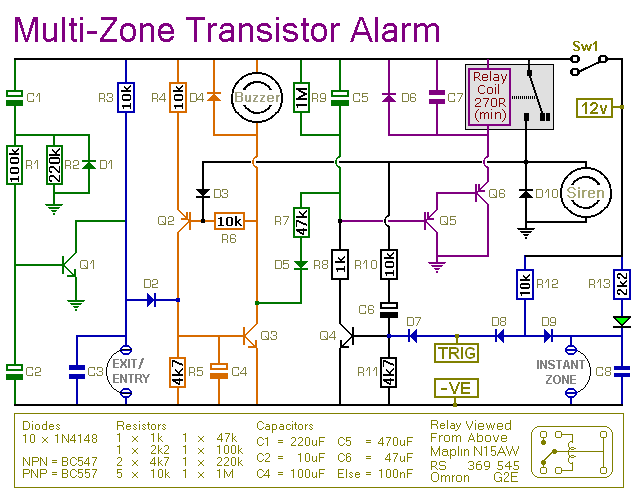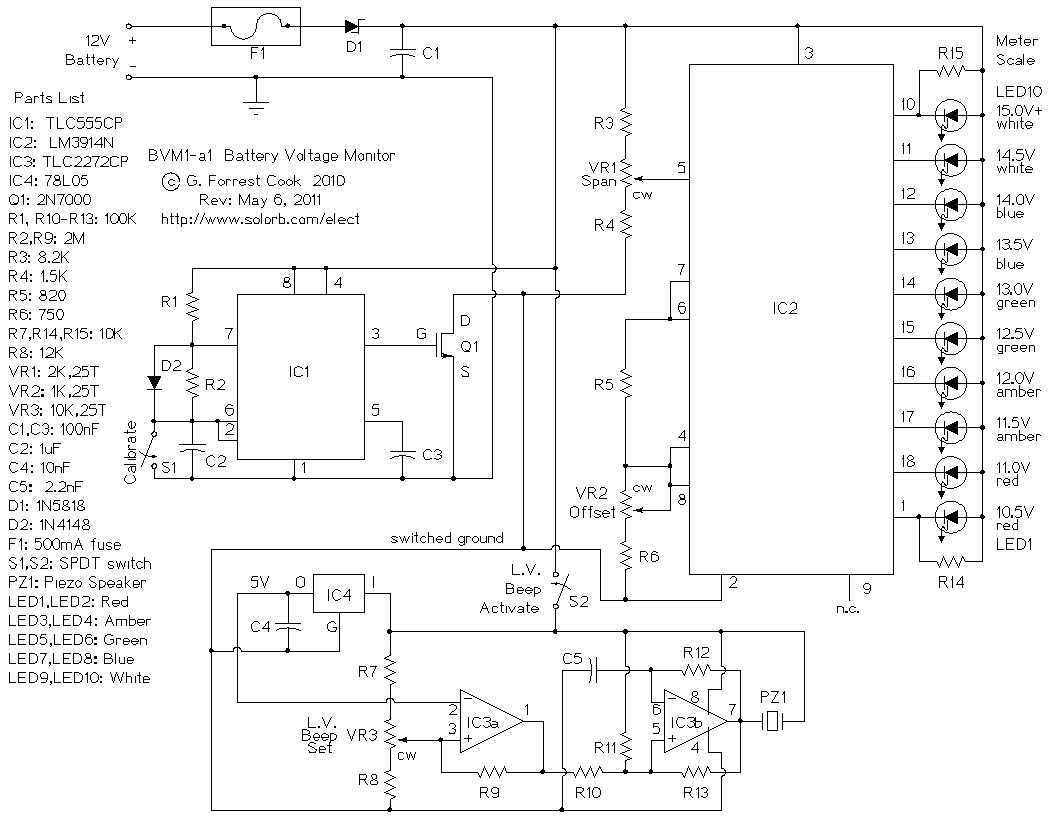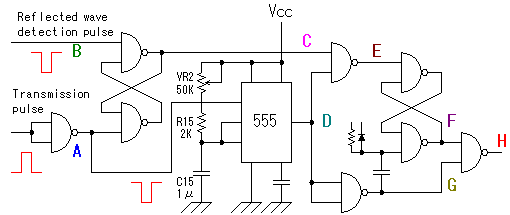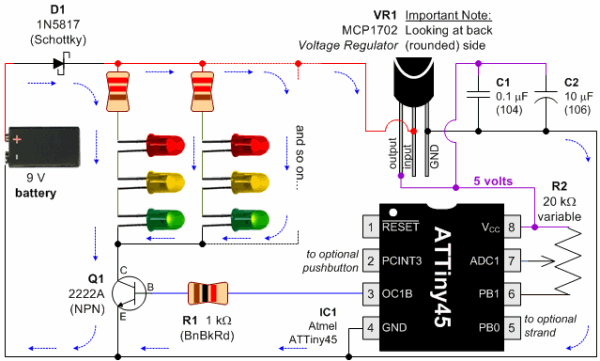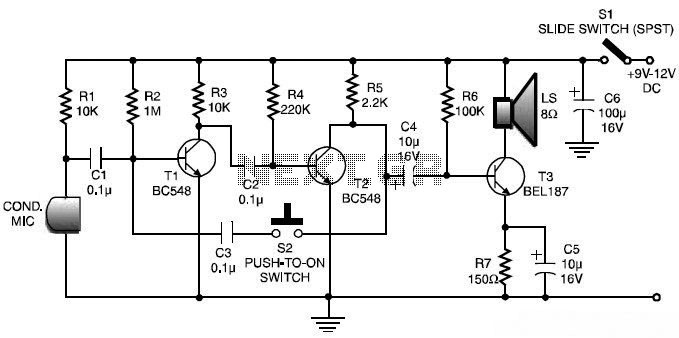
Low Cost Burglar Alarm For Boats
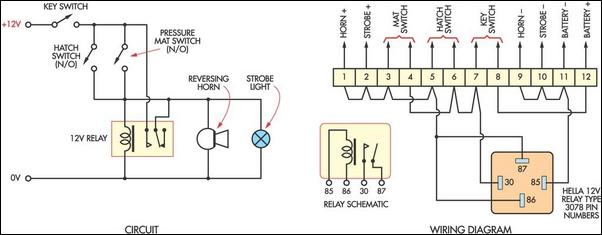
This cost-effective burglar alarm utilizes a 12V strobe light and a truck reversing horn as the visual and audible alarm outputs. The alarm mechanism consists of a 12V horn relay and several pressure mat switches. This straightforward design ensures that the alarm remains functional even if the entry point is immediately closed, while drawing no current in the armed state. To operate independently from the boat's power supply, it can run on a single 12V battery or two 6V alkaline lantern batteries connected in series, which are expected to last over two years. An advantage of using a lantern battery is its limited operational time of less than one hour when powering the alarm actively, thereby complying with noise pollution regulations. For areas with strict noise regulations, an alarm timer can be integrated into the circuit between the battery positive and the key switch. The key switch may be installed in the cockpit bulkhead and connected to two normally open (NO) switches wired in parallel. One switch is a pressure mat positioned on the cockpit floor near the entry, concealed under a suitable carpet or pliable cover. If a pressure mat is not feasible, a mechanical switch such as an automobile boot lid or door courtesy light switch can be used to protect the main entry. The second switch can be utilized to safeguard against entry through a forward hatch or an additional wheelhouse door. Multiple normally open (NO) switches can be incorporated into this system, all connected in parallel. When the alarm is triggered, the relay closes and latches due to its contact wiring, activating both the horn and strobe light. The recommended truck reversing horn is the Hella 6023 intermittent reversing buzzer, which produces an 85dB sound level with a current drain of 0.9A at 12V. The suggested strobe light is the Hella 1657, featuring an amber lens in a weatherproof housing, flashing approximately once per second with a current drain of 0.25A at 12V. The strobe can be installed externally on the deck or within the main cabin, ensuring visibility through most ports and windows. Wiring for both the warning horn and strobe light should be concealed for aesthetic and security purposes.
This burglar alarm circuit is designed to provide a reliable and efficient security solution for boats, ensuring that unauthorized entry is detected and signaled effectively. The system's architecture includes a central control unit, which is the 12V horn relay, that manages the response of the alarm when triggered by any of the connected pressure mat switches or mechanical switches.
The pressure mat switch, placed strategically at the entry point, serves as the primary detection mechanism. When pressure is applied, the switch closes, sending a signal to the horn relay. This relay, once activated, not only powers the audible warning from the truck reversing horn but also engages the strobe light, providing a dual alert system that is both loud and visually striking.
To enhance the system's functionality, the inclusion of an alarm timer can be beneficial, particularly in regions with stringent noise control regulations. This timer can be set to limit the duration of alarm activation, thus preventing excessive noise while still ensuring security.
The choice of components, such as the Hella 6023 horn and Hella 1657 strobe light, reflects a balance between performance and power consumption. The horn's sound output of 85dB is adequate to alert nearby individuals, while the strobe light's flashing rate and weatherproof design make it suitable for outdoor use, ensuring visibility under various environmental conditions.
The circuit design should take into account the need for concealed wiring to prevent tampering and maintain a clean aesthetic. Proper routing of wires, along with secure connections, will enhance the reliability of the system. Additionally, consideration should be given to the placement of the key switch and any additional NO switches to maximize coverage and minimize false alarms.
Overall, this burglar alarm circuit represents a straightforward yet effective approach to enhancing security for boats, with a focus on ease of installation, long battery life, and compliance with noise regulations.This low-cost burglar alarm employs a 12V strobe light and a truck reversing horn as the visible and audible alarm outputs while the alarm itself is a 12V horn relay and some pressure mat switches. This simple approach has the benefit that the alarm continues to operate even if the entry point is immediately closed and it draws no current while in
the armed condition. To make it independent of the boat supply it runs from a single 12V or two 6V alkaline lantern batteries connected in series. These should last well in excess of two years. An advantage of a lantern battery is that it will last less than an hour while powering the alarm in its active role.
This means the alarm system will not seriously contravene noise pollution laws. If there are very strict noise regulations in your area, you can fit an alarm timer, available from some electronic shops, in the circuit between the battery positive and the key switch. The key switch can be installed in the cockpit bulkhead and connects to two normally open (NO) switches wired in parallel.
One switch is a pressure mat placed on the cockpit floor near the entry, underneath a suitable piece of carpet or pliable cover. If a pressure mat is unsuitable, the main entry can be protected by a mechanical switch such as an automobile boot lid or door courtesy light switch.
The second switch can be used to protect against entry through a forward hatch or second wheelhouse door. Any number of normally open (NO) switches can be installed in this system, all wired in parallel. If the alarm is tripped, the relay closes and latches on due to the wiring of its contacts and the horn and strobe light are powered.
The suggested truck reversing horn is the Hella 6023 intermittent reversing buzzer which has an 85dB sound level and a current drain of 0. 9A at 12V. The suggested strobe is a Hella 1657 which has an amber lens in a weatherproof housing. This strobe flashes about once per second and the current drain at 12V is 0. 25A. The strobe can be installed outside on deck or in the main cabin where its flash will be seen through most ports and windows.
Wiring to both the warning horn and strobe light should be concealed. 🔗 External reference
This burglar alarm circuit is designed to provide a reliable and efficient security solution for boats, ensuring that unauthorized entry is detected and signaled effectively. The system's architecture includes a central control unit, which is the 12V horn relay, that manages the response of the alarm when triggered by any of the connected pressure mat switches or mechanical switches.
The pressure mat switch, placed strategically at the entry point, serves as the primary detection mechanism. When pressure is applied, the switch closes, sending a signal to the horn relay. This relay, once activated, not only powers the audible warning from the truck reversing horn but also engages the strobe light, providing a dual alert system that is both loud and visually striking.
To enhance the system's functionality, the inclusion of an alarm timer can be beneficial, particularly in regions with stringent noise control regulations. This timer can be set to limit the duration of alarm activation, thus preventing excessive noise while still ensuring security.
The choice of components, such as the Hella 6023 horn and Hella 1657 strobe light, reflects a balance between performance and power consumption. The horn's sound output of 85dB is adequate to alert nearby individuals, while the strobe light's flashing rate and weatherproof design make it suitable for outdoor use, ensuring visibility under various environmental conditions.
The circuit design should take into account the need for concealed wiring to prevent tampering and maintain a clean aesthetic. Proper routing of wires, along with secure connections, will enhance the reliability of the system. Additionally, consideration should be given to the placement of the key switch and any additional NO switches to maximize coverage and minimize false alarms.
Overall, this burglar alarm circuit represents a straightforward yet effective approach to enhancing security for boats, with a focus on ease of installation, long battery life, and compliance with noise regulations.This low-cost burglar alarm employs a 12V strobe light and a truck reversing horn as the visible and audible alarm outputs while the alarm itself is a 12V horn relay and some pressure mat switches. This simple approach has the benefit that the alarm continues to operate even if the entry point is immediately closed and it draws no current while in
the armed condition. To make it independent of the boat supply it runs from a single 12V or two 6V alkaline lantern batteries connected in series. These should last well in excess of two years. An advantage of a lantern battery is that it will last less than an hour while powering the alarm in its active role.
This means the alarm system will not seriously contravene noise pollution laws. If there are very strict noise regulations in your area, you can fit an alarm timer, available from some electronic shops, in the circuit between the battery positive and the key switch. The key switch can be installed in the cockpit bulkhead and connects to two normally open (NO) switches wired in parallel.
One switch is a pressure mat placed on the cockpit floor near the entry, underneath a suitable piece of carpet or pliable cover. If a pressure mat is unsuitable, the main entry can be protected by a mechanical switch such as an automobile boot lid or door courtesy light switch.
The second switch can be used to protect against entry through a forward hatch or second wheelhouse door. Any number of normally open (NO) switches can be installed in this system, all wired in parallel. If the alarm is tripped, the relay closes and latches on due to the wiring of its contacts and the horn and strobe light are powered.
The suggested truck reversing horn is the Hella 6023 intermittent reversing buzzer which has an 85dB sound level and a current drain of 0. 9A at 12V. The suggested strobe is a Hella 1657 which has an amber lens in a weatherproof housing. This strobe flashes about once per second and the current drain at 12V is 0. 25A. The strobe can be installed outside on deck or in the main cabin where its flash will be seen through most ports and windows.
Wiring to both the warning horn and strobe light should be concealed. 🔗 External reference
